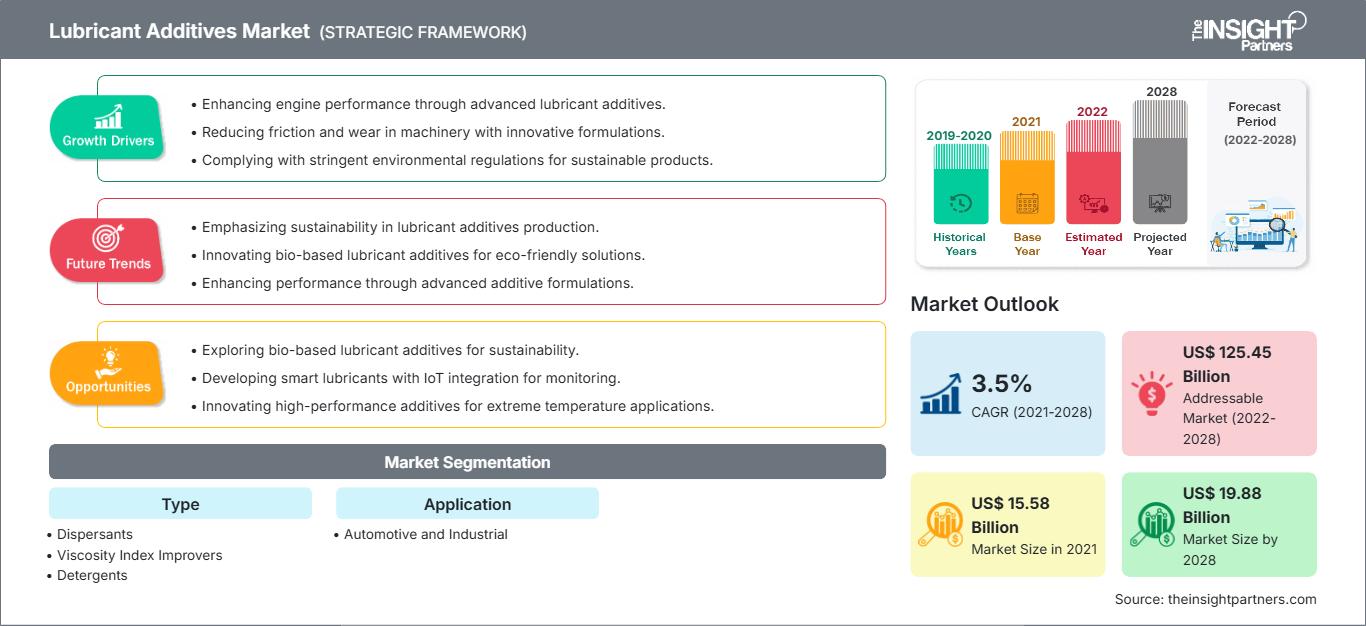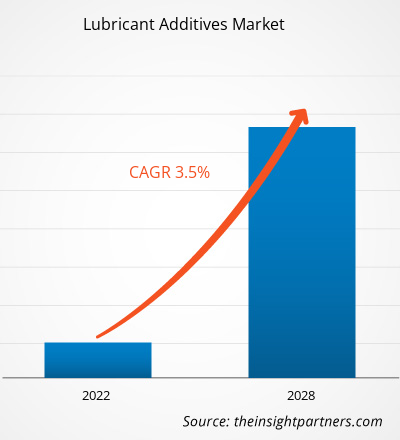Der Markt für Schmierstoffadditive wurde im Jahr 2021 auf 15.584,9 Millionen US-Dollar geschätzt und soll bis 2028 19.880,12 Millionen US-Dollar erreichen; von 2021 bis 2028 wird eine durchschnittliche jährliche Wachstumsrate (CAGR) von 3,5 % erwartet.
Schmierstoffadditive werden bei der Verarbeitung synthetischer Schmierstoffe verwendet, die aufgrund ihrer besseren Eigenschaften als natürliches Mineralöl häufig in der Industrie und im Automobilsektor eingesetzt werden. Der Aufschwung der Industrie- und Automobilsektoren steigert somit die Nachfrage nach synthetischen Schmierstoffen. Motoröl ist das am häufigsten verwendete Schmiermittel in der Automobil- und Industriebranche. Es verfügt über hervorragende physikalische und chemische Eigenschaften, darunter einen höheren Viskositätsindex, eine geringere Flüchtigkeit, einen niedrigeren Pourpoint und eine höhere thermische Stabilität. Die Zugabe von Additiven wie Viskositätsmodifikatoren und Pourpoint-Erniedrigern in Schmierstoffen verbessert deren physikalische und chemische Eigenschaften. Daher ist die umfassende Anwendung von Schmierstoffen in verschiedenen Branchen der Schlüsselfaktor für den Markt für Schmierstoffadditive, da die Mischung von Schmierstoffen mit Additiven deren Leistung und Lebensdauer verbessert.
Im Jahr 2020 hatte der asiatisch-pazifische Raum den größten Anteil am globalen Markt für Schmierstoffadditive. Der wichtigste Faktor für das Marktwachstum in dieser Region ist die steigende Nachfrage nach Schmierstoffadditiven aus der Automobil- und anderen Fertigungsindustrien. Die zunehmende Entwicklung von Automobilteilen und -komponenten in der Region mit der steigenden Fahrzeugproduktion, gepaart mit kontinuierlichen Innovationen der Kraftstoffhersteller, schafft lukrative Möglichkeiten für den Schmierstoffmarkt, was wiederum das Marktwachstum antreibt. Darüber hinaus dürfte die wachsende Bautätigkeit, insbesondere in China und Indien, globale Marktteilnehmer dazu bewegen, sich im asiatisch-pazifischen Raum niederzulassen. Schwere Nutzfahrzeuge sind in China weit verbreitet, da die Verbraucher sie aufgrund ihrer hohen Tragfähigkeit und robusten Federung bevorzugen. Daher sind sie im Transportwesen hilfreich. Schwere Nutzfahrzeuge, zum Beispiel Lkw, werden aufgrund ihrer hohen Tragfähigkeit häufig in der Logistik, im Bauwesen und in der Landwirtschaft eingesetzt. Sie werden hauptsächlich für den Transport von Schutt und Materialien von einem Ort zum anderen in jedem Gelände verwendet. All diese Faktoren werden die Marktnachfrage nach Schmierstoffzusätzen antreiben.
Passen Sie diesen Bericht Ihren Anforderungen an
Sie erhalten kostenlos Anpassungen an jedem Bericht, einschließlich Teilen dieses Berichts oder einer Analyse auf Länderebene, eines Excel-Datenpakets sowie tolle Angebote und Rabatte für Start-ups und Universitäten.
Markt für Schmierstoffadditive: Strategische Einblicke

-
Holen Sie sich die wichtigsten Markttrends aus diesem Bericht.Dieses KOSTENLOSE Beispiel umfasst Datenanalysen, die von Markttrends bis hin zu Schätzungen und Prognosen reichen.
Auswirkungen der COVID-19-Pandemie auf den Markt für Schmierstoffadditive
Die COVID-19-Pandemie hatte 2020 schwerwiegende Auswirkungen auf den Weltmarkt, da die Lieferketten für Rohstoffe zur Herstellung von Schmierstoffadditiven unterbrochen wurden. Die Lockerung der Lockdown-Maßnahmen in mehreren Ländern und die Wiederaufnahme der Betriebstätigkeit in vielen Branchen haben ab 2021 zur Wiederbelebung der Nachfrage nach Schmierstoffadditiven beigetragen. Darüber hinaus hat das schnelle Tempo der COVID-19-Impfprogramme das Wachstum des Marktes für Schmierstoffadditive unterstützt.
Markteinblicke
Schnelles industrielles Wachstum begünstigt Wachstum des Marktes für Schmierstoffadditive
Schmierstoffe gehören zu den wichtigsten Komponenten in der Industrie, da sie dazu beitragen, dass Geräte mit hoher Effizienz und maximaler Zuverlässigkeit arbeiten. Mineralische und synthetische Schmierstoffe, Fette, Kompressorenöle und Kühlschmierstoffe sind verschiedene Arten von Schmierstoffen, die als Additive unter anderem in der Automobil-, Öl- und Gas-, Textil-, Glas-, Energieerzeugungs-, Papier- und Zellstoff-, Chemie- und Petrochemie-, Landwirtschafts-, Fertigungs-, Lebensmittel- und Getränke- sowie Pharmaindustrie verwendet werden. Das weltweite Wachstum dieser Branchen führt zu einer enormen Nachfrage nach Schmierstoffen und Schmierstoffadditiven. Die Textilveredelungsindustrie, insbesondere im asiatisch-pazifischen Raum, erzeugt eine hohe Nachfrage nach Industrieschmierstoffen. Auch in der Textilindustrie im asiatisch-pazifischen Raum besteht eine hohe Nachfrage nach Industrieschmierstoffen. Der umfassende Einsatz von Schmierstoffen in verschiedenen Branchen und das schnelle Wachstum dieses Industriesektors sind daher die Hauptfaktoren, die den Markt für Schmierstoffadditive antreiben.
Anwendungseinblicke
Basierend auf der Anwendung ist der Markt in Automobil und Industrie segmentiert. Das Automobilsegment hatte 2020 einen größeren Marktanteil. Schmierstoffadditive werden in Motorölen und Motorenölen verwendet, um die Ausflockung anorganischer Substanzen im Öl während des Betriebs zu verhindern. Es besteht eine hohe Nachfrage nach Schmierstoffadditiven in Mehrbereichsmotorenölen, Getriebeölen, Automatikgetriebeflüssigkeiten, Servolenkungsflüssigkeiten, Schmierfetten und einigen Hydraulikflüssigkeiten, um die Viskosität bei hohen Temperaturen aufrechtzuerhalten. Viele Automobilhersteller investieren in die Verbesserung der Kraftstoffeffizienz von Fahrzeugen, was in den kommenden Jahren voraussichtlich weiter zum Marktwachstum beitragen wird.
Einige der wichtigsten Marktteilnehmer auf dem Markt für Schmierstoffadditive sind Evonik Industries AG; The Lubrizol Corporation; LANXESS, Nouryon; Mol-lub Kft.; Dover Chemical Corporation; Croda International plc; Chevron Corporation; BASF SE; und EXXON MOBIL CORPORATION. Diese Unternehmen bieten ein breites Produktportfolio für den Markt für Schmierstoffadditive. Diese Unternehmen sind in den Entwicklungsregionen präsent, was lukrative Möglichkeiten für Schmierstoffadditive bietet. Diese Marktteilnehmer konzentrieren sich stark auf die Entwicklung qualitativ hochwertiger und innovativer Produkte, um die Anforderungen der Kunden zu erfüllen.
Berichts-Spotlights
- Fortschreitende Branchentrends im Markt für Schmierstoffadditive helfen den Akteuren bei der Entwicklung effektiver langfristiger Strategien
- Geschäftswachstumsstrategien in entwickelten und sich entwickelnden Märkten
- Quantitative Analyse des Marktes für Schmierstoffadditive von 2019 bis 2028
- Schätzung der weltweiten Nachfrage nach Schmierstoffadditiven
- Porters Fünf-Kräfte-Analyse zur Veranschaulichung der Wirksamkeit von Käufern und Lieferanten im Markt für Schmierstoffadditive
- Jüngste Entwicklungen zum Verständnis des wettbewerbsorientierten Marktszenarios
- Markttrends und -aussichten sowie Faktoren, die das Wachstum des Marktes für Schmierstoffadditive vorantreiben und hemmen
- Unterstützung im Entscheidungsprozess durch Hervorhebung von Marktstrategien, die das kommerzielle Interesse untermauern
- Die Größe des Marktes für Schmierstoffadditive an verschiedenen Knotenpunkten
- Detaillierte Übersicht und Segmentierung des Markt sowie die Dynamik der Schmierstoffadditivbranche
- Größe des Schmierstoffadditivmarktes in verschiedenen Regionen mit vielversprechenden Wachstumschancen
Schmierstoffadditive
Regionale Einblicke in den Markt für SchmierstoffadditiveDie Analysten von The Insight Partners haben die regionalen Trends und Faktoren, die den Markt für Schmierstoffadditive im Prognosezeitraum beeinflussen, ausführlich erläutert. In diesem Abschnitt werden auch die Marktsegmente und die geografische Lage in Nordamerika, Europa, dem asiatisch-pazifischen Raum, dem Nahen Osten und Afrika sowie Süd- und Mittelamerika erörtert.
Umfang des Marktberichts zu Schmierstoffadditiven
| Berichtsattribut | Einzelheiten |
|---|---|
| Marktgröße in 2021 | US$ 15.58 Billion |
| Marktgröße nach 2028 | US$ 19.88 Billion |
| Globale CAGR (2021 - 2028) | 3.5% |
| Historische Daten | 2019-2020 |
| Prognosezeitraum | 2022-2028 |
| Abgedeckte Segmente |
By Typ
|
| Abgedeckte Regionen und Länder |
Nordamerika
|
| Marktführer und wichtige Unternehmensprofile |
|
Dichte der Marktteilnehmer für Schmierstoffadditive: Verständnis ihrer Auswirkungen auf die Geschäftsdynamik
Der Markt für Schmierstoffadditive wächst rasant. Die steigende Nachfrage der Endverbraucher ist auf Faktoren wie veränderte Verbraucherpräferenzen, technologische Fortschritte und ein stärkeres Bewusstsein für die Produktvorteile zurückzuführen. Mit der steigenden Nachfrage erweitern Unternehmen ihr Angebot, entwickeln Innovationen, um den Bedürfnissen der Verbraucher gerecht zu werden, und nutzen neue Trends, was das Marktwachstum weiter ankurbelt.

- Holen Sie sich die Markt für Schmierstoffadditive Übersicht der wichtigsten Akteure
Markt für Schmierstoffadditive
-
Typ
- Dispergiermittel
- Viskositätsindexverbesserer
- Detergenzien
- Verschleißschutzmittel
- Emulgatoren
- Sonstige
-
Anwendung
-
- Automobil
- Industrie
Firmenprofile
- Evonik Industries AG
- The Lubrizol Corporation
- LANXESS
- Nouryon
- Mol-lub Kft.
- Dover Chemical Corporation
- Croda International plc
- Chevron Corporation
- BASF SE
- EXXON MOBIL CORPORATION
- Historische Analyse (2 Jahre), Basisjahr, Prognose (7 Jahre) mit CAGR
- PEST- und SWOT-Analyse
- Marktgröße Wert/Volumen – Global, Regional, Land
- Branchen- und Wettbewerbslandschaft
- Excel-Datensatz
Aktuelle Berichte
Verwandte Berichte
Erfahrungsberichte
Grund zum Kauf
- Fundierte Entscheidungsfindung
- Marktdynamik verstehen
- Wettbewerbsanalyse
- Kundeneinblicke
- Marktprognosen
- Risikominimierung
- Strategische Planung
- Investitionsbegründung
- Identifizierung neuer Märkte
- Verbesserung von Marketingstrategien
- Steigerung der Betriebseffizienz
- Anpassung an regulatorische Trends






















 Kostenlose Probe anfordern für - Markt für Schmierstoffadditive
Kostenlose Probe anfordern für - Markt für Schmierstoffadditive